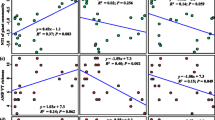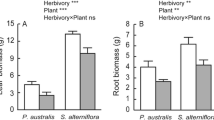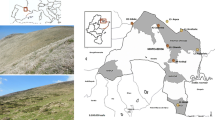Abstract
Herbivory, competition and soil fertility interactively shape plant communities and exhibit an important role in modifying conditions for host-dependent fungal symbionts. However, field studies on the combined impacts of natural herbivory, competition and soil fertility on root fungal symbionts are rare. We asked how mammalian herbivory, fertilization, liming and plant–plant competition affect the root colonization of arbuscular mycorrhizal fungi (AMF) and dark septate endophytic (DSE) fungi of the dicot herb, Solidago virgaurea. The 2-year full-factorial experiment was conducted in two contrasting habitats: non-acidic and acidic mountain tundra. We found that herbivory increased arbuscular colonization (i.e. the site of resource exchange) at fertile non-acidic sites, where vegetation was rich in species having AMF symbionts, whereas at infertile acidic sites, where plants having AMF symbiont are scarce, the response was the opposite. Herbivory of the host plant negatively affected DSE hyphal and sclerotial colonization in unfertilized plots, possibly due to reduced carbon flow from the host plant while there was no effect of herbivory in fertilized plots. DSE colonization was highest in unfertilized exclosures where soil nutrient concentrations were also lowest. Liming had a negative effect on DSE hyphal colonization, and its effect also interacted with herbivory and the habitat. Biomass removal of the neighboring plants did not affect the root colonization percent of either arbuscules or DSE. Our results show that the impacts of aboveground mammalian herbivory, soil nutrient availability and specific habitat conditions on belowground root fungal symbionts are highly dependent on each other. Arbuscule response to herbivory appeared to be regulated by specific habitat conditions possibly caused by differences in the AMF availability in the soil while DSE response was associated with availability of host-derived carbon. Our result of the relationship between herbivory and soil nutrients suggests an important role of DSE in ecosystem processes.



Similar content being viewed by others
References
Aunapuu M, Dahlgren J, Oksanen T, Grellmann D, Oksanen L, Olofsson J, Rammul Ü, Schenider M, Johansen B, Hygen HO (2008) Spatial patterns and dynamic responses of Arctic food webs corroborate the exploitation ecosystem hypothesis (EEH). Am Nat 171:249–262
Bakker ES, Ritchie ME, Olff H, Milchunas DG, Knops JMH (2006) Herbivore impact on grassland plant diversity depends on habitat productivity and herbivore size. Ecol Lett 9:780–788
Barto EK, Rillig MC (2010) Does herbivory really suppress mycorrhiza? A meta-analysis. J Ecol 98:745–753
Bennett AE, Bever JD (2007) Mycorrhizal species differentially alter plant growth and response to herbivory. Ecology 88:210–218
Bennett AE, Alers-Garcia J, Bever JD (2006) Three-way interactions among mutualistic mycorrhizal fungi, plants and plant enemies: hypotheses and synthesis. Am Nat 167:141–152
Caldwell BA, Jumpponen A, Trappe JM (2000) Utilization of major detrital substrates by dark-septate, root endophytes. Mycologia 92:230–232
Caporn SJM, Song W, Read DJ, Lee JA (1995) The effect of repeated nitrogen fertilisation on mycorrhizal infection in heather (Calluna vulgaris (L.) Hull). New Phytol 129:605–609
Cornwell WK, Bedford BL, Chapin CT (2001) Occurrence of arbuscular mycorrhizal fungi in a phosphorus-poor wetland and mycorrhizal response to phosphorus fertilization. Am J Bot 88:1824–1829
Crawley M (1997) Life history and environment. In: Crawley M (ed) Plant Ecology. Blackwell, Oxford, pp 73–131
Crawley MJ (2007) The R book. Wiley, Chichester
Currah RS, Tsuneda A, Murakami S (1993) Morphology and ecology of Phialocephala fortinii in roots of Rhododendron brachycarpum. Can J Bot 71:1639–1644
Daft MJ, El Giahmi AA (1978) Effects of arbuscular mycorrhiza on plant growth. VIII. Effects of defoliation and light on selected hosts. New Phytol 80:365–372
Eom A-H, Wilson GWT, Hartnett DC (2001) Effects of ungulate grazers on arbuscular mycorrhizal symbiosis and fungal community structure in tallgrass prairie. Mycologia 93:233–242
Eskelinen A (2008) Herbivore and neighbour effects on tundra plants depend on species identity, nutrient availability and local environmental conditions. J Ecol 96:155–165
Eskelinen A, Stark S, Männistö M (2009) Links between plant community composition, soil organic matter quality and microbial communities in contrasting tundra habitats. Oecologia 161:113–123
Frank DA (2008) Ungulate and topographic control of nitrogen: phosphorus stoichiometry in a temperate grassland; soils, plants and mineralization rates. Oikos 117:591–601
Gange AC, Bower E, Brown VK (2002) Differential effects of insect herbivory on arbuscular mycorrhizal colonization. Oecologia 131:103–112
Gange AC, Brown VK, Aplin DM (2005) Ecological specifity of arbuscular mycorrhizae: evidence from foliar- and seed-feeding insects. Ecology 86:603–611
Gehring CA, Whitham TG (1994) Interactions between aboveground herbivores and the mycorrhizal mutualists of plants. Trends Ecol Evol 9:251–255
Gehring CA, Whitham TG (2002) Mycorrhizae-herbivore interactions: population and community consequences. In: Van der Heijden MJG, Sanders IR (eds) Mycorrhizal ecology. Springer, Berlin, pp 295–320
Gough L, Ramsey EA, Johnson DR (2007) Plant–herbivore interactions in Alaskan arctic tundra change with soil nutrient availability. Oikos 116:407–418
Grace JB, Tilman D (1990) Perspectives on plant competition. Academic Press, San Diego
Grigera G, Oesterheld M (2004) Mycorrhizal colonization patterns under contrasting grazing and topographic conditions in the flooding pampa (Argentina). J Range Manag 57:601–605
Grime JP (1973) Competitive exclusion in herbaceous vegetation. Nature 242:344–347
Hartley SE, Amos L (1999) Competitive interactions between Nardus stricta L. and Calluna vulgaris (L.) Hull: the effect of fertilizer and defoliation on above- and belowground performance. J Ecol 87:330–340
Hartnett DC, Samenus RJ, Fischer LE, Hetrick BAD (1994) Plant demographic responses to mycorrhizal symbiosis in tallgrass prairie. Oecologia 99:21–26
Heijne B, Dueck TA, Van der Eerden LJ, Heil GW (1994) Effects of atmospheric ammonia and ammonium sulphate on vesicular–arbuscular mycorrhizal infection in three heathland species. New Phytol 127:685–696
Hoeksema JD, Chaudhary VB, Gehring CA, Collins Johnson N, Karst J, Koide RT, Pringle A, Zabinski C, Bever JD, Moore JC, Wilson GWT, Klironomos JN, Umbanhowar J (2010) A meta-analysis of context-dependency in plant response to inoculation with mycorrhizal fungi. Ecol Lett 13:394–407
Högberg MN, Högberg P, Myrold DD (2007) Is microbial community composition in boreal forest soils determined by pH, C to N ratio, the trees or all three? Oecologia 150:590–601
Holland JN, Cheng W, Crossley DA Jr (1996) Herbivore-induced changes in plant carbon allocation: assessment of below-ground C fluxes using carbon-14. Oecologia 107:87–94
Järvinen A (1987) Basic climatological data on the Kilpisjärvi area, NW Finnish Lapland. Kilpisjärvi Notes 10:1–16
Johansson M (2000) The influence of ammonium nitrate on the root growth and ericoid mycorrhizal colonization of Calluna vulgaris (L.) Hull from a Danish heathland. Oecologia 123:418–424
Johnson NC (2010) Tansley review: resource stoichiometry elucidates the structure and function of arbuscular mycorrhizas across scales. New Phytol 185:631–647
Johnson NC, Graham JH, Smith FA (1997) Functioning of mycorrhizal associations along the mutualism–parasitism continuum. New Phytol 135:575–585
Johnson NC, Rowland DL, Corkidi L, Egerton-Warburton LM, Allen EB (2003) Nitrogen enrichment alters mycorrhizal allocation at five mesic to semiarid grasslands. Ecology 84:1895–1908
Johnson NC, Wilson GWT, Bowker MA, Wilson JA, Miller RM (2010) Resource limitation is a driver of local adaptation in mycorrhizal symbioses. Proc Natl Acad Sci USA 107:2093–2098
Jumpponen A (2001) Dark septate endophytes—are they mycorrhizal? Mycorrhiza 11:207–211
Jumpponen A, Trappe JM (1998) Dark septate endophytes: a review of facultative biotrophic root-colonizing fungi. New Phytol 140:295–310
Kinzel H (1983) Influence of limestone, silicates and soil pH on vegetation. In: Lange OL, Nobel PS, Osmond CB, Ziegler H (eds) Physiological plant ecology III. Responses to the chemical and biological environment. Springer, Berlin, pp 201–244
Kula AAR, Hartnett DC, Wilson GWT (2005) Effects of mycorrhizal symbiosis on tallgrass prairie plant–herbivore interactions. Ecol Lett 8:61–69
Louda SM, Keeler KH, Holt DR (1990) Herbivore influences on plant performance and competitive interactions. In: Grace JB, Tilman D (eds) Perspectives on plant competition. Academic Press, San Diego, pp 413–444
Lugo MA, González Maza ME, Cabello MA (2003) Arbuscular mycorrhizal fungi in a mountain grassland II: seasonal variation of colonization studied, along with its relation to grazing and metabolic host type. Mycologia 95:407–415
Madigan M, Martinko J, Parker J (2003) Brock biology of microorganisms. Prentice Hall, Upper Saddle River
Mandyam K, Jumpponen A (2005) Seeking the elusive function of the root-colonizing dark septate endophytes. Stud Mycol 53:173–189
Mandyam K, Jumpponen A (2008) Seasonal and temporal dynamics of arbuscular and dark septate endophytic fungi in a tallgrass prairie ecosystem are minimally affected by nitrogen enrichment. Mycorrhiza 18:145–155
Marschner H, Kirkby E, Cakmak I (1996) Effect of mineral nutritional status on shoot-root partitioning of photoassimilates and cycling of mineral nutrients. J Exp Bot 47:1255–1263
McGonigle TP, Miller MH, Evans DG, Fairchild GL, Swan JA (1990) A new method which gives an objective measure of colonization of roots by vesicular–arbuscular mycorrhizal fungi. New Phytol 115:495–501
McHugh TA, Gehring CA (2006) Below-ground interactions with arbuscular mycorrhizal shrubs decrease the performance of pinyon pine and the abundance of its ectomycorrhizas. New Phytol 171:171–178
McNaughton SJ (1983) Compensatory growth as a response to herbivory. Oikos 40:329–336
Medina-Roldán E, Arredondo JT, Huber-Sannwald E, Chapa-Vargas L, Olalde-Portugal V (2008) Grazing effects on fungal root symbionts and carbon and nitrogen storage in a shortgrass steppe in Central Mexico. J Arid Env 72:546–556
Michelsen A, Graglia E, Schmidt I, Jonasson S, Sleep D, Quarmby C (1999) Differential responses of grass and dwarf shrub to long-term changes in soil microbial biomass C, N and P following factorial addition of NPK fertilizer, fungicide and labile carbon to a heath. New Phytol 143:523–538
Murray TR, Frank DA, Gehring CA (2010) Ungulate and topographic control of arbuscular mycorrhizal fungal spore community composition in a temperate grassland. Ecology 91:815–827
Oksanen L, Fretwell SD, Arruda J, Niemelä P (1981) Exploitation ecosystems in gradients of primary productivity. Am Nat 118:240–261
Phillips JM, Hayman DS (1970) Improved procedures for clearing roots and staining parasitic and vesicular–arbuscular mycorrhizal fungi for rapid assessment of infection. Trans Br Mycol Soc 55:158–161
Pietikäinen A, Kytöviita M-M, Vuoti U (2005) Mycorrhiza and seedling establishment in a subarctic meadow: effects of fertilization and defoliation. J Veg Sci 16:175–182
Pinheiro JC, Bates DM (2000) Mixed-effects models in S and S-PLUS. Springer, New York
Post E, Forchhammer MC, Bret-Harte S, Callaghan TV, Christensen TR, Elberling B, Fox AD, Gilg O, Hik DS, Hoye TT, Ims RA, Jeppesen E, Klein DR, Madsen J, McGuire AD, Rysgaard S, Schindler DE, Stirling I, Tamstorf MP, Tyler NJC, Van der Wal R, Welker J, Wookey PA, Schmidt NM, Aastrup P (2009) Ecological dynamics across the arctic associated with recent climate change. Science 325:1355–1358
Postma JWM, Olsson PÅ, Falkengren-Grerup U (2007) Root colonisation by arbuscular mycorrhizal, fine endophytic and dark septate fungi across a pH gradient in acid beech forest. Soil Biol Biochem 39:400–408
Read DJ (1991) Mycorrhizas in ecosystems. Experientia 47:376–391
Read DJ, Koucheki HK, Johnson J (1976) Vesicular–arbuscular mycorrhiza in natural vegetation systems. I. The occurrence of infection. New Phytol 77:641–653
Reynolds HL, Packer A, Bever JD, Clay K (2003) Grassroots ecology: plant–microbe–soil interaction as drivers of plant community structure and dynamics. Ecology 84:2281–2291
Rodriguez RJ, White JF Jr, Arnold AE, Redman RS (2009) Fungal endophytes: diversity and functional roles. New Phytol 182:314–330
Ruotsalainen AL, Väre H, Vestberg M (2002) Seasonality of root fungal colonization in low-alpine herbs. Mycorrhiza 12:29–36
Simard SW, Durrall DM (2004) Mycorrhizal networks: a review of their extent, function, and importance. Can J Bot 82:1140–1165
Smith SE, Read DJ (2008) Mycorrhizal symbiosis, 3rd edn. Academic Press, London
R Development Core Team (2007) R: a language and environment for statistical computing. R foundation for Statistical Computing, Vienna, Austria. ISBN: 3-900051-07-0. http://www.R-project.org
Titus JH, Leps J (2000) The response of arbuscular mycorrhizae to fertilization, mowing, and removal of dominant species in a diverse oligotrophic wet meadow. Am J Bot 87:392–401
Trappe JM (1987) Phylogenetic and ecologic aspects of mycotrophy in the angiosperms from an evolutionary standpoint. In: Safir GR (ed) Ecophysiology of VA mycorrhizal plants. RC Press, Boca Raton, pp 5–25
Tuomi J, Kytöviita M-M, Härdling R (2001) Cost efficiency of nutrient acquisition and the advantage of mycorrhizal symbiosis for the host plant. Oikos 92:62–70
Urcelay C, Bret-Harte MS, Diaź S, Chapin FS (2003) Mycorrhizal colonization mediated by species interactions in arctic tundra. Oecologia 137:399–404
Usuki F, Narisawa K (2007) A mutualistic symbiosis between a dark septate endophytic fungus, Heteroconium chaetospira, and a nonmycorrhizal plant, Chinese cabbage. Mycologia 99:175–184
Van der Heijden MGA, Horton TR (2009) Socialism in soil? Importance of mycorrhizal fungal networks for facilitation in natural ecosystems. J Ecol 97:1139–1150
Van der Heijden MGA, Bardgett RD, van Straalen NM (2008) The unseen majority: soil microbes as drivers of plant diversity and productivity in terrestrial ecosystems. Ecol Lett 11:296–310
Wallace LL (1987) Mycorrhizas in grasslands: interactions of ungulates, fungi and drought. New Phytol 105:619–632
Wearn JA, Gange A (2007) Above-ground herbivory causes rapid and sustained changes in mycorrhizal colonization of grasses. Oecologia 153:959–971
Wookey PH, Aerts R, Bardgett RD, Baptist F, Bråthen KA, Cornelissen JCH, Gough L, Hartley IP, Hopkins DW, Lavorel S, Shaver G (2009) Ecosystem feedbacks and cascade processes: understanding their role in the responses of Arctic and alpine ecosystems to environmental change. Glob Chang Biol 15:1153–1172
Zar JH (1999) Biostatistical analysis. Prentice-Hall, London
Acknowledgments
We thank Henna Roppola for microscopic work with the root material and Kilpisjärvi Biological Station for providing laboratory facilities, assistance and lodging during the fieldwork. Risto Virtanen is thanked for developing ideas for the experiment and Stella Copeland, Catherine A. Gehring and two anonymous reviewers for useful comments on the manuscript. This study was financed by the Kone foundation (to A.L.R.) and the Academy of Finland (to A.L.R., project #122092), and the Societas pro Fauna et Flora Fennica, the Oskar Öflund Foundation, the Oulu University Scholarship Foundation and Ella and Georg Ehrnrooth Foundation (to A.E.). All experiments complied with the laws of Finland at the time the experiments were performed.
Author information
Authors and Affiliations
Corresponding author
Additional information
Communicated by Melinda Smith.
Rights and permissions
About this article
Cite this article
Ruotsalainen, A.L., Eskelinen, A. Root fungal symbionts interact with mammalian herbivory, soil nutrient availability and specific habitat conditions. Oecologia 166, 807–817 (2011). https://doi.org/10.1007/s00442-011-1928-x
Received:
Accepted:
Published:
Issue Date:
DOI: https://doi.org/10.1007/s00442-011-1928-x




